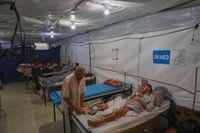On the eve of a high-stakes meeting between Israeli Prime Minister Benjamin Netanyahu and U.S. President Donald Trump, the Israel-Hamas war continues to exact a devastating toll on Gaza, with the death count now surpassing 66,000 Palestinians. As both leaders prepare to discuss a potential ceasefire in Washington on September 29, 2025, the situation on the ground remains dire, and the world’s attention is fixed on whether a breakthrough is finally within reach.
According to the Gaza Health Ministry, the death toll in the conflict has climbed to 66,005, with a staggering 168,162 wounded since Hamas launched its October 7, 2023, attack on Israel—a move that triggered the ongoing Israeli military response. The ministry, which operates under the Hamas-run administration, does not distinguish between civilians and militants in its reporting, but has stated that women and children make up around half of those killed. Despite its affiliation, the ministry’s data is widely regarded by the United Nations and independent humanitarian experts as a credible estimate of civilian casualties.
In the last 24 hours alone leading up to September 28, 2025, 79 more people were brought to hospitals, underscoring the relentless pace of violence. Local hospitals in central Gaza reported at least 10 fatalities after strikes hit homes in the Nuseirat refugee camp, as reported by the Associated Press. Residents described a night filled with the roar of explosions, likely stemming from the demolition of buildings using explosive-laden vehicles and robots. “They were nonstop,” said Sayed Baker, a Palestinian sheltering near Shifa hospital, capturing the terror that has become a daily reality for Gaza’s residents.
The Israeli military, for its part, confirmed that it had struck 140 Hamas military targets over the past 24 hours, including militants, observation equipment, and infrastructure. On Sunday, the military also leveled the 16-story Macca tower in Gaza City after warning residents to evacuate. The building, according to Israeli officials, housed “military infrastructure belonging to Hamas.” No casualties were reported from this particular strike, but it marks the latest in a series of demolitions as Israel expands its offensive deeper into Gaza.
The consequences of the military campaign have been catastrophic for civilians. Vast areas of Gaza have been reduced to rubble, and about 90% of the population has been displaced, according to multiple reports. Humanitarian experts and aid organizations warn that Gaza City is now experiencing famine, compounding the crisis for those who remain. The United Nations and many independent experts continue to view the Gaza Health Ministry’s figures as reliable, despite the ongoing war of narratives between the parties involved.
Amid this backdrop, diplomatic efforts are intensifying. Netanyahu, facing mounting international pressure to end the conflict, announced that Israel is actively working on a new ceasefire plan in collaboration with the White House. “We’re working on it,” Netanyahu told Fox News Sunday’s “The Sunday Briefing.” “It’s not been finalized yet, but we’re working with President Trump’s team, actually as we speak, and I hope we can -- we can make it a go.”
The centerpiece of these efforts is a 21-point ceasefire proposal, discussed by Trump with Arab leaders on September 27, 2025, on the sidelines of the United Nations General Assembly in New York. According to Arab officials briefed on the plan—who spoke on condition of anonymity because the proposal has not been formally announced—the framework calls for an immediate ceasefire, the release of all hostages held by Hamas within 48 hours, and a gradual withdrawal of Israeli forces from Gaza. The officials emphasized that the proposal is not final and that changes are likely as negotiations continue.
Netanyahu has remained steadfast in his public remarks, vowing to continue military operations until Hamas is destroyed. However, he has also reiterated an offer to allow Hamas operatives to leave Gaza as part of any deal that ends the conflict and secures the release of hostages. “If they finish the war, release all the hostages, we let them out,” he said, signaling a possible opening for negotiation.
For its part, Hamas has indicated a willingness to engage with peace proposals, though it has yet to receive an official offer from Egyptian and Qatari mediators. A Hamas official stated that the group is prepared to “study any proposals positively and responsibly,” and previously expressed willingness to release all hostages in return for an end to the war and a full Israeli withdrawal from the territory.
Despite these glimmers of hope, the path to peace remains fraught with obstacles. Ceasefire talks have repeatedly stalled, even as international and domestic protests against the war have intensified. Key Western allies have joined a growing list of countries recognizing a Palestinian state, much to Israel’s chagrin. The European Union is reportedly considering sanctions, and there are increasing calls for sports and cultural boycotts against Israel.
Netanyahu’s recent speech at the United Nations General Assembly captured the defiance of the Israeli government in the face of this global pressure. Drawing a controversial parallel between the October 7 attacks and the September 11 terror strikes in the United States, Netanyahu declared, “Granting the Palestinians a state one mile from Jerusalem after October 7 is akin to granting al-Qaeda a state one mile from New York City after September 11.” He went on, “This is sheer madness. It’s insane, and we won’t do it,” sharply criticizing Western nations that have moved to formally recognize Palestinian statehood. “You didn’t do something right. You did something wrong, horribly wrong,” he insisted, warning that such steps would only embolden further attacks on Jews and “innocent people everywhere.”
On the ground, violence has not been confined to Gaza. On September 28, 2025, Israeli security forces shot dead an alleged attacker near Nablus in the West Bank, where tensions have also been rising. The incident, which left a man seriously injured, was praised by Hamas. The West Bank, along with Gaza and East Jerusalem, was captured by Israel during the 1967 Mideast war and remains a central issue in the broader Israeli-Palestinian conflict.
As Netanyahu and Trump prepare to meet, the world waits to see whether the proposed ceasefire plan can gain traction or if the war’s deadly cycle will continue. The stakes could hardly be higher for both the region and the thousands of civilians caught in the crossfire.
With the death toll mounting and humanitarian conditions worsening by the day, the coming week may prove pivotal in shaping the next chapter of the Israel-Hamas conflict—and in determining whether the suffering in Gaza can finally be brought to an end.





